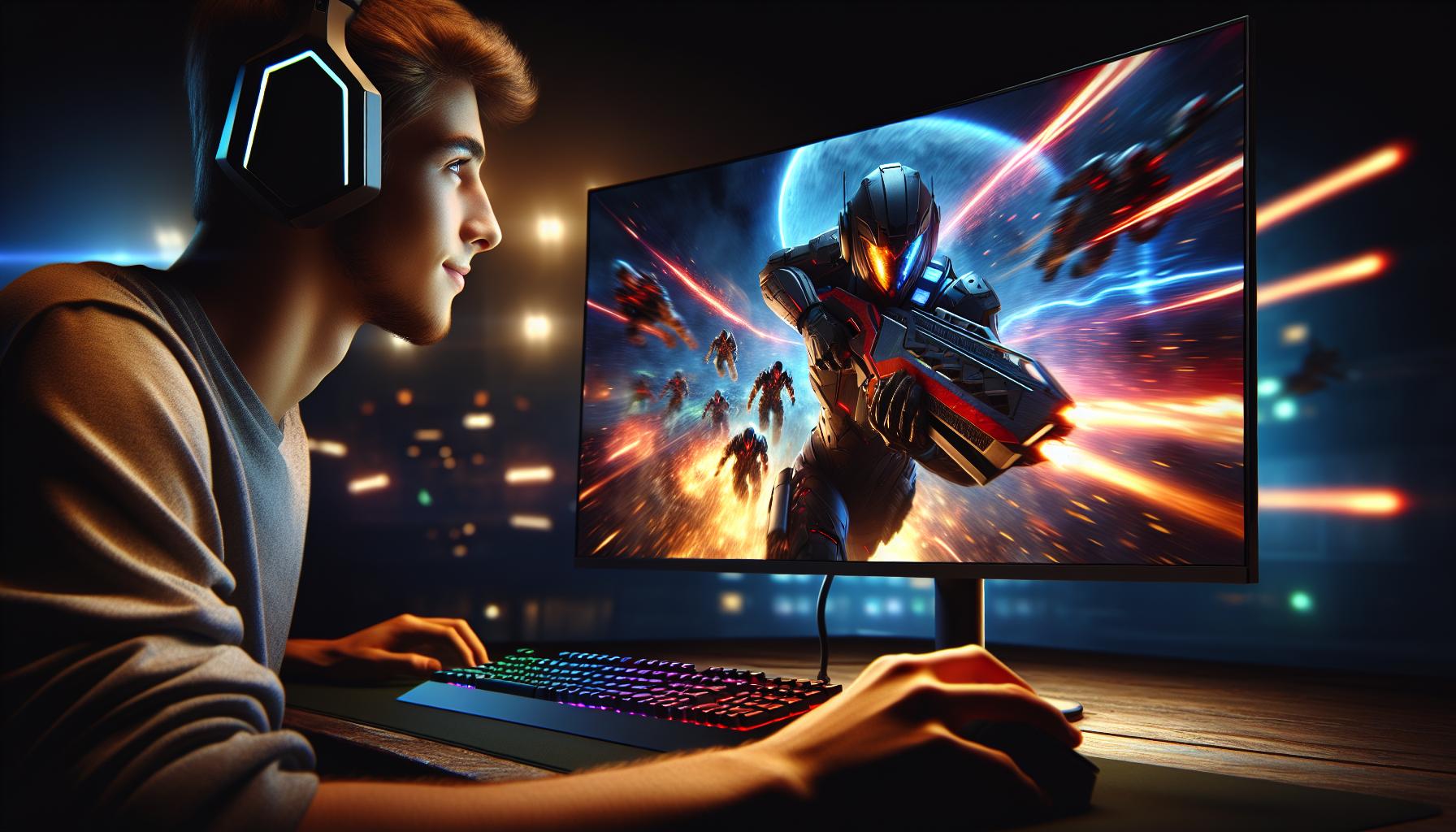When it comes to gaming, every detail counts, and your monitor’s refresh rate can make a world of difference. I’ve often found myself wondering if a 165 Hz display is worth the investment. With so many options available, it’s crucial to understand how this specific refresh rate impacts your gaming experience. A higher refresh rate can lead to smoother gameplay and reduced motion blur, which is essential for fast-paced games. If you’re serious about competitive gaming, you might be curious whether 165 Hz gives you that edge. In this article, I’ll dive into the benefits of 165 Hz monitors and help you decide if it’s the right choice for your setup.
- Higher Refresh Rate Benefits: A 165 Hz refresh rate significantly enhances gaming by providing smoother gameplay and reducing motion blur, crucial for fast-paced titles.
- Improved Visual Clarity: Players experience improved visual fluidity, reducing screen tearing and enhancing immersion during intense gaming sessions.
- Reduced Input Lag: A 165 Hz monitor decreases input lag, allowing faster on-screen responses which are essential in competitive gaming.
- Competitive Edge: Gamers can achieve better precision and tracking of targets, leading to a strategic advantage in multiplayer scenarios.
- Consider Hardware Compatibility: Ensure your graphics card supports 165 Hz refresh rates to maximize performance and prevent potential bottlenecks.
- Weighing Gaming Preferences: Assessing whether you prioritize fast-paced gaming or visual detail can help determine if a 165 Hz monitor is the right choice for your setup.
Is 165 Hz Good for Gaming
Refresh rate refers to the number of times a monitor updates its display per second, measured in hertz (Hz). A higher refresh rate leads to a more responsive gaming experience and enhances visual quality.
What Is Refresh Rate?
Refresh rate indicates how many frames per second a monitor can display. For example, a 60 Hz refresh rate means the display refreshes 60 times in one second. Higher refresh rates, such as 120 Hz or 165 Hz, allow for smoother motion and improved clarity in fast-moving scenes, making them advantageous for gamers.
How Refresh Rate Affects Gaming
Refresh rate directly impacts gameplay and visual fluidity. Increased refresh rates reduce screen tearing and motion blur, allowing for clearer visuals during intense action sequences. Competitive gamers benefit from refresh rates of 165 Hz, as these displays provide an edge in responsiveness and tracking fast-moving targets in first-person shooters or racing games. A 165 Hz monitor can deliver a distinct advantage over lower refresh rates by ensuring smoother gameplay and enhanced overall immersion in the gaming experience.
Benefits Of 165 Hz For Gaming

A 165 Hz refresh rate offers significant advantages for gamers. The increased refresh rate directly contributes to enhanced gameplay and improved overall performance.
Smoother Gameplay Experience
Smoother gameplay hinges on higher refresh rates. A 165 Hz monitor presents 165 frames per second, resulting in fluid visuals and reducing motion blur. Fast-paced action games, such as first-person shooters or racing titles, benefit from this smoothness, allowing for precise aiming and better tracking of moving targets. Gamers appreciate the seamless transitions during intense moments, enhancing immersion and enjoyment.
Improved Responsiveness
Improved responsiveness is another key benefit of a 165 Hz display. Higher refresh rates decrease input lag, meaning actions appear on-screen faster in response to player commands. This responsiveness is crucial in competitive gaming situations, where split-second decisions can dictate the outcome. The quick reaction time fosters a more engaging experience, allowing me to perform better under pressure and maintain a competitive edge in multiplayer scenarios.
Comparison With Other Refresh Rates

Understanding the differences between refresh rates helps determine whether a 165 Hz monitor meets gaming needs. Below, I compare 165 Hz with both 60 Hz and 144 Hz refresh rates.
60 Hz vs. 165 Hz
A 60 Hz monitor updates its display 60 times per second. In contrast, a 165 Hz display refreshes 165 times per second. This significant difference impacts gameplay.
- Visual Smoothness: A 165 Hz monitor provides much smoother motion, enhancing the gaming experience, especially in fast-paced titles.
- Input Lag: A lower refresh rate like 60 Hz can introduce noticeable input lag, while 165 Hz reduces this lag considerably, improving reaction time during gameplay.
- Screen Tearing: Higher refresh rates, such as 165 Hz, effectively minimize screen tearing, which often occurs at 60 Hz. This reduction allows for a more immersive experience.
144 Hz vs. 165 Hz
A 144 Hz monitor is a popular choice for gamers, as it delivers decent performance. However, a 165 Hz monitor offers slightly better capabilities.
- Refresh Rate: While both rates provide a smooth experience, 165 Hz leads to marginally improved visuals and responsiveness over 144 Hz.
- Competitive Advantage: Gamers benefit from the additional frames per second that 165 Hz provides, which can be crucial in highly competitive scenarios.
- Price and Availability: Often, 165 Hz monitors come at a slightly higher price point. Still, the benefits may justify the investment, particularly for dedicated gamers seeking an edge.
Factors To Consider When Choosing A Monitor

Choosing the right monitor for gaming involves several crucial factors that influence performance and overall experience. Here are two key considerations to keep in mind.
Gaming Preferences
Gaming preferences vary among players, impacting the choice of monitor. Competitive gamers typically favor higher refresh rates, like 165 Hz, for fast-paced action games. They benefit from smoother visuals and reduced motion blur, giving them an edge in precision and response time. Conversely, casual gamers might prioritize color accuracy and resolution over refresh rates, focusing on detailed visuals for immersive storytelling experiences. Understanding specific gaming needs helps narrow down monitor selections.
Hardware Compatibility
Hardware compatibility plays a vital role in the effectiveness of a monitor’s refresh rate. A 165 Hz monitor requires a graphics card capable of generating that many frames per second. For optimal performance, gamers should check both the GPU specifications and the connection type, such as DisplayPort or HDMI. Ensuring that the system can handle the desired refresh rate prevents bottlenecks, allowing for a seamless gaming experience. Compatibility with other peripherals, like a gaming mouse or keyboard, enhances overall responsiveness, contributing to a better performance. A 165 Hz monitor can truly elevate your gaming experience. The smoother visuals and reduced motion blur make a noticeable difference in fast-paced games. If you’re serious about gaming and want that competitive edge, investing in a 165 Hz display is worth considering. It’s not just about the numbers; it’s about how it feels when you’re in the heat of battle. The enhanced responsiveness and clarity can transform your gameplay. Just make sure your hardware can keep up to fully enjoy the benefits. Overall, a 165 Hz monitor can be a game-changer for dedicated gamers.

